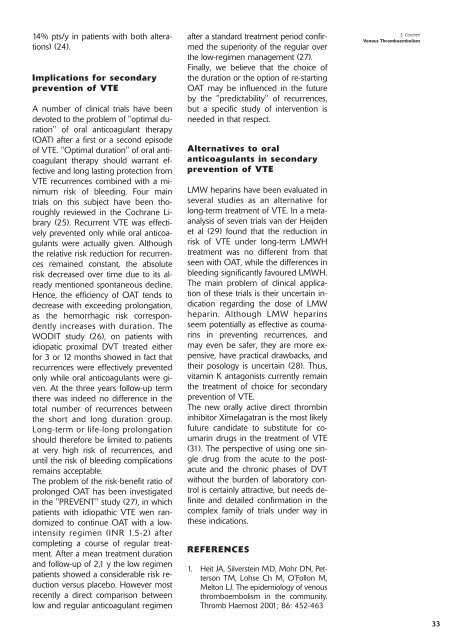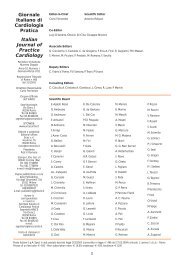Scarica il documento in formato pdf (556 KB) - ANCE
Scarica il documento in formato pdf (556 KB) - ANCE
Scarica il documento in formato pdf (556 KB) - ANCE
You also want an ePaper? Increase the reach of your titles
YUMPU automatically turns print PDFs into web optimized ePapers that Google loves.
14% pts/y <strong>in</strong> patients with both alterations)<br />
(24).<br />
Implications for secondary<br />
prevention of VTE<br />
A number of cl<strong>in</strong>ical trials have been<br />
devoted to the problem of "optimal duration"<br />
of oral anticoagulant therapy<br />
(OAT) after a first or a second episode<br />
of VTE. "Optimal duration" of oral anticoagulant<br />
therapy should warrant effective<br />
and long last<strong>in</strong>g protection from<br />
VTE recurrences comb<strong>in</strong>ed with a m<strong>in</strong>imum<br />
risk of bleed<strong>in</strong>g. Four ma<strong>in</strong><br />
trials on this subject have been thoroughly<br />
reviewed <strong>in</strong> the Cochrane Library<br />
(25). Recurrent VTE was effectively<br />
prevented only wh<strong>il</strong>e oral anticoagulants<br />
were actually given. Although<br />
the relative risk reduction for recurrences<br />
rema<strong>in</strong>ed constant, the absolute<br />
risk decreased over time due to its already<br />
mentioned spontaneous decl<strong>in</strong>e.<br />
Hence, the efficiency of OAT tends to<br />
decrease with exceed<strong>in</strong>g prolongation,<br />
as the hemorrhagic risk correspondently<br />
<strong>in</strong>creases with duration. The<br />
WODIT study (26), on patients with<br />
idiopatic proximal DVT treated either<br />
for 3 or 12 months showed <strong>in</strong> fact that<br />
recurrences were effectively prevented<br />
only wh<strong>il</strong>e oral anticoagulants were given.<br />
At the three years follow-up term<br />
there was <strong>in</strong>deed no difference <strong>in</strong> the<br />
total number of recurrences between<br />
the short and long duration group.<br />
Long-term or life-long prolongation<br />
should therefore be limited to patients<br />
at very high risk of recurrences, and<br />
unt<strong>il</strong> the risk of bleed<strong>in</strong>g complications<br />
rema<strong>in</strong>s acceptable.<br />
The problem of the risk-benefit ratio of<br />
prolonged OAT has been <strong>in</strong>vestigated<br />
<strong>in</strong> the "PREVENT" study (27), <strong>in</strong> which<br />
patients with idiopathic VTE wen randomized<br />
to cont<strong>in</strong>ue OAT with a low<strong>in</strong>tensity<br />
regimen (INR 1.5-2) after<br />
complet<strong>in</strong>g a course of regular treatment.<br />
After a mean treatment duration<br />
and follow-up of 2,1 y the low regimen<br />
patients showed a considerable risk reduction<br />
versus placebo. However most<br />
recently a direct comparison between<br />
low and regular anticoagulant regimen<br />
after a standard treatment period confirmed<br />
the superiority of the regular over<br />
the low-regimen management (27).<br />
F<strong>in</strong>ally, we believe that the choice of<br />
the duration or the option of re-start<strong>in</strong>g<br />
OAT may be <strong>in</strong>fluenced <strong>in</strong> the future<br />
by the "predictab<strong>il</strong>ity" of recurrences,<br />
but a specific study of <strong>in</strong>tervention is<br />
needed <strong>in</strong> that respect.<br />
Alternatives to oral<br />
anticoagulants <strong>in</strong> secondary<br />
prevention of VTE<br />
LMW hepar<strong>in</strong>s have been evaluated <strong>in</strong><br />
several studies as an alternative for<br />
long-term treatment of VTE. In a metaanalysis<br />
of seven trials van der Heijden<br />
et al (29) found that the reduction <strong>in</strong><br />
risk of VTE under long-term LMWH<br />
treatment was no different from that<br />
seen with OAT, wh<strong>il</strong>e the differences <strong>in</strong><br />
bleed<strong>in</strong>g significantly favoured LMWH.<br />
The ma<strong>in</strong> problem of cl<strong>in</strong>ical application<br />
of these trials is their uncerta<strong>in</strong> <strong>in</strong>dication<br />
regard<strong>in</strong>g the dose of LMW<br />
hepar<strong>in</strong>. Although LMW hepar<strong>in</strong>s<br />
seem potentially as effective as coumar<strong>in</strong>s<br />
<strong>in</strong> prevent<strong>in</strong>g recurrences, and<br />
may even be safer, they are more expensive,<br />
have practical drawbacks, and<br />
their posology is uncerta<strong>in</strong> (28). Thus,<br />
vitam<strong>in</strong> K antagonists currently rema<strong>in</strong><br />
the treatment of choice for secondary<br />
prevention of VTE.<br />
The new orally active direct thromb<strong>in</strong><br />
<strong>in</strong>hibitor Ximelagatran is the most likely<br />
future candidate to substitute for coumar<strong>in</strong><br />
drugs <strong>in</strong> the treatment of VTE<br />
(31). The perspective of us<strong>in</strong>g one s<strong>in</strong>gle<br />
drug from the acute to the postacute<br />
and the chronic phases of DVT<br />
without the burden of laboratory control<br />
is certa<strong>in</strong>ly attractive, but needs def<strong>in</strong>ite<br />
and deta<strong>il</strong>ed confirmation <strong>in</strong> the<br />
complex fam<strong>il</strong>y of trials under way <strong>in</strong><br />
these <strong>in</strong>dications.<br />
REFERENCES<br />
1. Heit JA, S<strong>il</strong>verste<strong>in</strong> MD, Mohr DN, Petterson<br />
TM, Lohse Ch M, O'Follon M,<br />
Melton LJ. The epidemiology of venous<br />
thromboembolism <strong>in</strong> the community.<br />
Thromb Haemost 2001; 86: 452-463<br />
S. Coccheri<br />
Venous Thromboembolism<br />
33
















